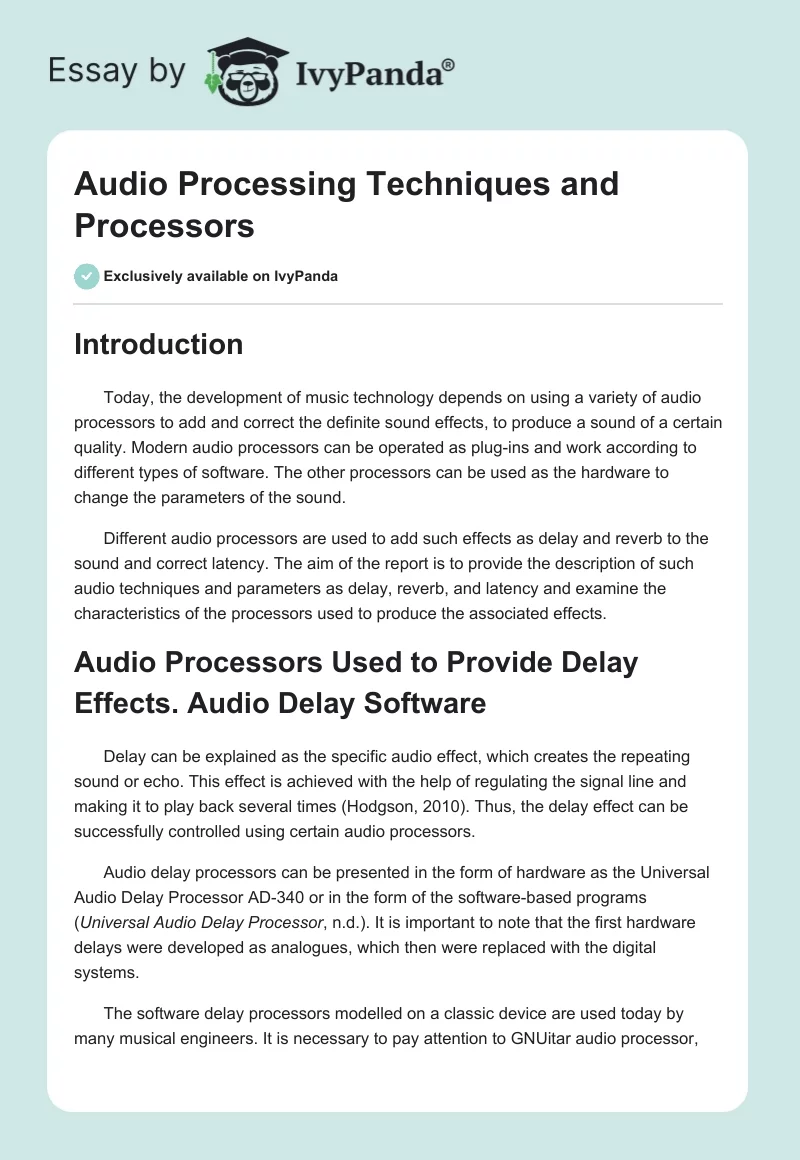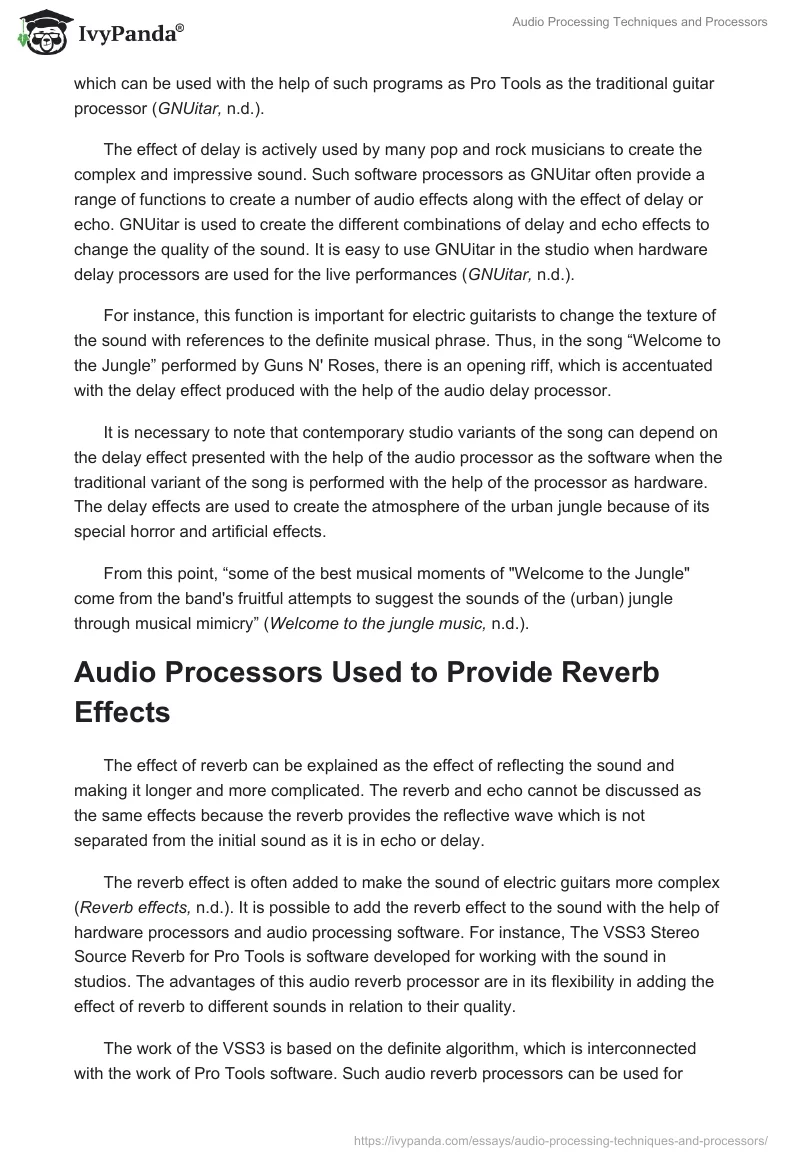Introduction
Today, the development of music technology depends on using a variety of audio processors to add and correct the definite sound effects, to produce a sound of a certain quality. Modern audio processors can be operated as plug-ins and work according to different types of software. The other processors can be used as the hardware to change the parameters of the sound.
Different audio processors are used to add such effects as delay and reverb to the sound and correct latency. The aim of the report is to provide the description of such audio techniques and parameters as delay, reverb, and latency and examine the characteristics of the processors used to produce the associated effects.
Audio Processors Used to Provide Delay Effects. Audio Delay Software
Delay can be explained as the specific audio effect, which creates the repeating sound or echo. This effect is achieved with the help of regulating the signal line and making it to play back several times (Hodgson, 2010). Thus, the delay effect can be successfully controlled using certain audio processors.
Audio delay processors can be presented in the form of hardware as the Universal Audio Delay Processor AD-340 or in the form of the software-based programs (Universal Audio Delay Processor, n.d.). It is important to note that the first hardware delays were developed as analogues, which then were replaced with the digital systems.
The software delay processors modelled on a classic device are used today by many musical engineers. It is necessary to pay attention to GNUitar audio processor, which can be used with the help of such programs as Pro Tools as the traditional guitar processor (GNUitar, n.d.).
The effect of delay is actively used by many pop and rock musicians to create the complex and impressive sound. Such software processors as GNUitar often provide a range of functions to create a number of audio effects along with the effect of delay or echo. GNUitar is used to create the different combinations of delay and echo effects to change the quality of the sound. It is easy to use GNUitar in the studio when hardware delay processors are used for the live performances (GNUitar, n.d.).
For instance, this function is important for electric guitarists to change the texture of the sound with references to the definite musical phrase. Thus, in the song “Welcome to the Jungle” performed by Guns N’ Roses, there is an opening riff, which is accentuated with the delay effect produced with the help of the audio delay processor.
It is necessary to note that contemporary studio variants of the song can depend on the delay effect presented with the help of the audio processor as the software when the traditional variant of the song is performed with the help of the processor as hardware. The delay effects are used to create the atmosphere of the urban jungle because of its special horror and artificial effects.
From this point, “some of the best musical moments of “Welcome to the Jungle” come from the band’s fruitful attempts to suggest the sounds of the (urban) jungle through musical mimicry” (Welcome to the jungle music, n.d.).
Audio Processors Used to Provide Reverb Effects
The effect of reverb can be explained as the effect of reflecting the sound and making it longer and more complicated. The reverb and echo cannot be discussed as the same effects because the reverb provides the reflective wave which is not separated from the initial sound as it is in echo or delay.
The reverb effect is often added to make the sound of electric guitars more complex (Reverb effects, n.d.). It is possible to add the reverb effect to the sound with the help of hardware processors and audio processing software. For instance, The VSS3 Stereo Source Reverb for Pro Tools is software developed for working with the sound in studios. The advantages of this audio reverb processor are in its flexibility in adding the effect of reverb to different sounds in relation to their quality.
The work of the VSS3 is based on the definite algorithm, which is interconnected with the work of Pro Tools software. Such audio reverb processors can be used for changing the sounds of vocal, guitar, piano, horns and many other instruments (VSS3 Stereo Source Reverb, n.d.). Modern reverb software is characterized by a lot of parameters and functions to add different reverb qualities to the sound.
Audio reverb processors are used to enhance the sound, make it natural or unnatural, or better than it was before correcting. The sound becomes full and complex. Moreover, the reverb can add some dramatic effect to the melody as it is in the song “Sorrow” performed by Pink Floyd (Echoing acoustics, n.d.).
The reverb effect can be discussed as appropriate for the live performance as well as for making recordings in the studio. The intro in “Sorrow” is almost the separated part of the song, which is accentuated with the help of the reverb effect (Reverb – good or bad?, n.d.).
Audio Processors Used to Correct Latency
Latency is one of the most typical audio effects, which make the sound worse and should be corrected with the help of audio processors. Thus, latency is a rather short delay “that occurs in audio systems due to the time it takes for sound to travel from place to place, and/or due to the time it takes for digital components to perform calculations” (Opening Pandora’s Box?, n.d.).
Latency can be audible and not. When latency is longer than several seconds it should be corrected to make the recording qualitative. The problem is in the fact latency is often the result of changing the sound with the help of definite devices (Hodgson, 2010).
Latency emerges when the producer or musical engineer uses definite digital filters to create the sound with certain parameters. The duration of latency can depend on the number of filters used (Hodgson, 2010). If delay and reverb effects can be added using hardware as well as software processors, latency can be effectively corrected with the help of software modeled on a device.
Pro Tools HD software works with the Automatic Delay Compensation, which is developed to reduce the latency (Latency and delay compensation, n.d). Moreover, “in cases where delay compensation is necessary to ensure that audio stays time aligned, there is a way to manually compensate for plug-in latencies by using the DigiRack Time Adjuster plug-in, or by slightly moving or “nudging” tracks” (Latency and delay compensation, n.d).
To provide the example of reducing latency, it is necessary to refer to Lester and Boley’s research in which they studied different effects of latency and the ways of its reduction. It was stated that latency is more critical during the solo performance and with references to the vocal when the effects of latency on playing instruments is not so significant (Lester & Boley, 2007).
Conclusion
Different types of audio processors can be used to enhance the sound and add such effects as reverb and delay to the sound. Hardware and software are appropriate and can be utilized with references to the work in studio or live performance. To correct latency, it is more effective to use software, which can be developed as the part of the audio delay processor.
References
Echoing acoustics. Web.
GNUitar. Web.
Hodgson, J. (2010). Understanding records: A field guide to recording practice. USA: Continuum. Latency and delay compensation. Web.
Lester, M., & Boley, J. (2007). The effects of latency on live sound monitoring. Web.
Opening Pandora’s Box? Web.
Reverb effects. Web.
Reverb – good or bad? Web.
Universal Audio Delay Processor. Web.
VSS3 Stereo Source Reverb. Web.
Welcome to the jungle music. Web.


